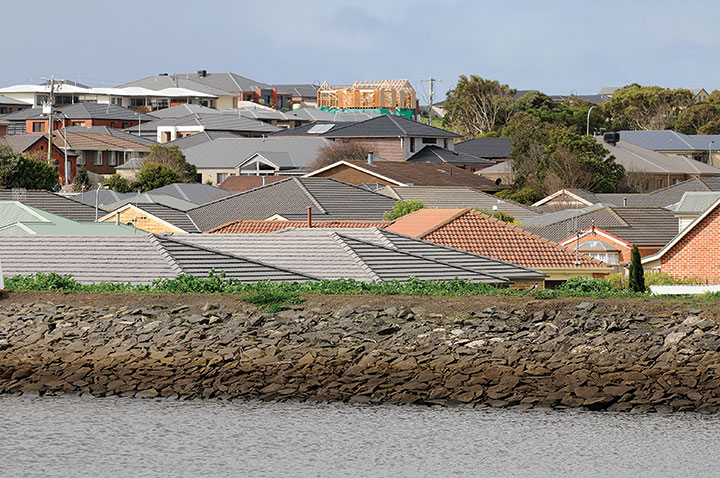case studies
Warrnambool roof water harvesting project
Contact
Insight:
Regional roof water harvesting can be used to supplement potable water supply
Project description
This roof water harvesting scheme collects and diverts roof water from all new houses and industrial buildings within new estates located in a growth corridor in the Great Ocean Road City of Warrnambool. Water is then transferred via gravity into an existing untreated water storage where it is treated through the existing treatment plant to provide drinking water for the city of Warrnambool.
The drivers
Working demonstration of innovative water management approach to meet the increased water supply demands in urban growth areas
- Wannon Water's Water Supply Demand Strategy 2007-2055 identified the need for new water resources within the 50-year planning period to meet the projected increase in demand.
- The growth areas in Warrnambool provided an opportunity to test innovative ways to save water and secure water supplies by constructing, monitoring and evaluating the roof water harvesting scheme as a pilot to identify risks and barriers and build confidence for other water authorities and councils to establish similar projects in applicable developments.
- The cost per megalitre (ML) was similar to the next preferred augmentation option (groundwater) and had additional environmental and social benefits.
The innovations
A leading example of integrated water management, collecting and diverting roof runoff for potable uses
- Regional harvesting of roof runoff: A separate collector pipe system has been installed for houses in new developments in the Warrnambool growth area. This pipe network (which includes trunk water mains and smaller collector pipes through the development) flows under gravity into the Brierly Basin where it is mixed with other untreated water.
- Treatment of rainwater: Harvested roof water is treated with other untreated water in the Brierly Basin at the existing Warrnambool water treatment plant to produce drinking water for the City of Warrnambool. Since roof water is generally cleaner than other surface runoff, additional treatment was not necessary.
- Hybrid model: Typically there are discussions around the benefits of centralised versus decentralised water solutions. This project provides a hybrid model that collects water using a decentralised system but treats the water in an existing centralised system, which eliminates many of the public health and safety risks associated with decentralised systems.
- Progressive expansion: The project commenced in 2011 in Warrnambool's northern growth areas with the initial pilot applied to 250 lots across two subdivisions. This will expand to over 3,000 homes and a new industrial estate as development in the growth corridor continues.
- Toolkit: Wannon Water created a toolkit that estimates capital and operating costs of rainwater harvesting schemes. The toolkit can calculate a net present cost (NPC) per ML, which can be used to directly compare the financial viability of rainwater harvesting schemes with other potential water supply solutions across Australia.

The lessons
- Collaborative management: Collaborative working relationships between project stakeholders were required to overcome management challenges, particularly coordinating the transfer of water from a local government authority and a water retailer.
- Compliance: The regulatory and cultural behaviours of the plumbing industry have been challenging. In particular, several domestic plumbers installed house connections with a 'business as usual' approach and connected the roof downpipes into the regular stormwater system.
- Reducing risk: While no significant risks were identified with the project, Wannon Water will be monitoring the water quality, inspecting connections to ensure there are no cross-connections, and will be responsible for the roof water harvesting network, including screening of leaves and other materials.
Transferability
There are opportunities to use this concept in most urban areas across Australia with an annual rainfall of over 700mm (lower annual rainfall may still be cost effective). This approach will be most cost effective where development is located near an existing raw water storage or transfer. The toolkit was used to determine the potential yield from a similar regional roof water harvesting scheme across each Australia capital city.
Project stats
Location
Warrnambool, VIC, Australia
Participants
Australian Government - Water for the Future
Victorian Government - Stormwater and Urban Recycling Fund
Cove Land Developments
Kriway Investments
Awards
Savewater Awards 2011 - Australian Achiever Winner
Australian Water Association (AWA) Victorian Water Awards 2012 - Highly Commended for Infrastructure Project Innovation
Environ Innovation in Sustainability Awards 2012 - Finalist
Tidy Towns Sustainable Communities Awards 2013
Stormwater Victoria 2013 - Award for Excellence
AWA Victorian Water Awards 2017 - Infrastructure Project Innovation Award
Additional information
Contact
The outcomes
 Cities providing ecosystem services
Cities providing ecosystem services

- Less urban excess stormwater entering waterways: Reducing stormwater volumes entering local waterways reduces erosion risk and improves waterway health.
- Improved environmental flows: Harnessing local water supplies reduces pressure on the water supply catchment of the Gellibrand River.
 Cities as water supply catchments
Cities as water supply catchments

- Augmentation of water supply system: Each new dwelling is expected to generate 145kL/year.
- Harvested roof water can meet urban demands: In an average rainfall year, the project is estimated to meet approximately 100% of the annual demand of the connected properties. In fact, early monitoring of the system identified more water was generated than used, which would result in excess water being used by other Warrnambool customers.
 Cities comprising water sensitive communities
Cities comprising water sensitive communities

- Informed residents: Flyers are sent out regularly to remind landowners that water is being harvesting from their roof and treated to form part of Warrnambool's drinking water supply. This builds their community consciousness and reduces risk of contamination.
- Toolkit to assist other growth areas: The toolkit has been developed to assist stakeholders in other growth areas to use similar roof water harvesting schemes.
Business Case
| Costs | Benefits |
|
|
Interested in this solution?
We partner with small and large companies, government and industry in Australia and around the world.
Comments